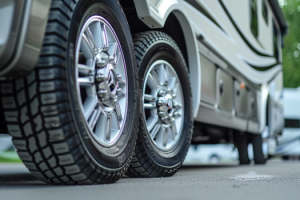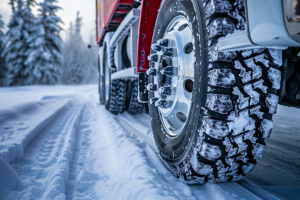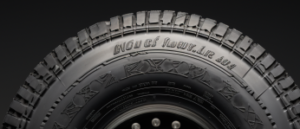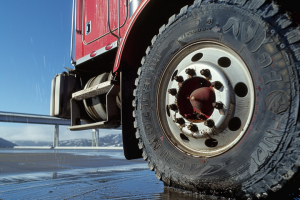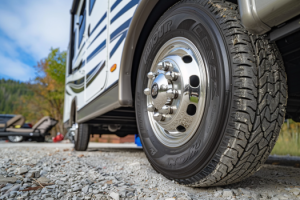Last Updated on April 25, 2024
Safe Driving on Run-Flat Truck Tires
Truck tires are the hidden heroes of the road, towing heavy cars and putting in many miles of abuse. Truck drivers and owners must prioritize the durability and safety of these tires. One crucial advancement in tire technology that has revolutionized truck safety is the development of run-flat tires. In this article, we will delve into the significance of truck tire longevity and, specifically, the role that run-flat tires play in ensuring safety on the road.
The Importance of Truck Tire Longevity
Overtime performance of truck tires is essential for road safety and cost savings. Why it matters is as follows:
- Cost-effectiveness: Regular truck tire replacements can be costly. By extending the life of your truck tires, you may prevent the need for frequent replacements, which will ultimately save you money.
- Reduced Downtime: A truck loses productivity every minute it is off the road, replacing tires. Durable tires minimize downtime and maintain the efficiency of your company.
- Environmental Impact: Tire production impacts the environment. Increasing the longevity of your truck’s tires helps lower waste and the carbon footprint related to tire manufacturing.
- Safety: Tire longevity is essential for safety. Well-maintained tires provide better traction, stability, and handling, reducing the risk of accidents caused by tire blowouts or failures.
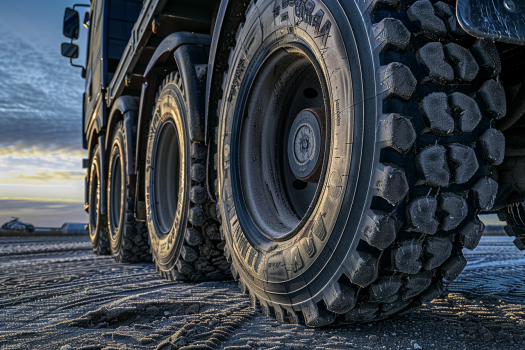
The Role of Run-Flat Tires in Ensuring Safety
Run-flat tires are designed to continue functioning even after sustaining a puncture. Here’s why they are indispensable for truck safety:
- Extended Mobility: Even after a puncture, trucks equipped with run-flat tires can drive a short distance (usually about 50 miles). This increased mobility gives drivers a safe window to get to a facility for maintenance or replacement.
- Decreased Risk: Unexpected tire failures, or blowouts, can cause accidents and a loss of control. Run-flat tires reduce this risk by offering control and stability, particularly when traveling at high speeds on the highway.
- Occupational protection: Commercial truck drivers must continue to steer their vehicle while it has a puncture to protect themselves and other drivers on the road.
- Minimized Roadside Hazards: With run-flat tires, the need to change a flat tire on the side of a busy highway is reduced, decreasing the potential hazards for the driver and other road users.
Understanding Run-Flat Truck Tires
Run-flat truck tires provide improved safety and convenience for truck drivers and owners, marking a substantial leap in tire technology. These specialty tires offer more mobility and lower the danger of tire failures while driving because they are made to continue functioning even after a puncture. This post will go into the specifics of run-flat truck tires, including how they’re made, their advantages, and how they make driving safer and more dependable for vehicles of all shapes and sizes. Whether you’re a commercial truck driver or a truck owner concerned about safety and performance, understanding run-flat tires is essential for making informed choices on the road.
What Are Run-Flat Tires?
Run-flat tires, sometimes referred to as self-supporting tires, are a particular kind of tire made to carry on driving even after they have lost air pressure or sustained a puncture. They accomplish this by having specific construction elements that enable them to support the car’s weight and function properly, even without air pressure. This is how run-flat tires function:
- Stronger Sidewalls: Run-flat tires can withstand the car’s weight when the air pressure is dropped because of their strengthened sidewalls, which offer structural support. This reinforcement is essential for the tire to remain stable and in its original shape.
- Internal Support Ring: Certain run-flat tires have an interior support ring composed of composite or hard rubber. Even without tread, this ring keeps the tire from collapsing by supporting the tread.
- Unique Rubber Compounds: Run-flat tires often use heat-resistant rubber compounds that offer improved durability to handle extended driving distances with low or no air pressure.
Types of Run-Flat Tires Suitable for Trucks
Regarding trucks, several run-flat tires are available, each catering to specific needs and applications. The primary types include:
- Self-Supporting Run-Flat tires: These run-flat tires fit a variety of trucks, from light-duty to heavy-duty, and are made to sustain the vehicle’s weight without the need for air pressure.
- Zero-pressure run-flat tire: Zero-pressure (ZP) tires are a particular kind of run-flat tire. In the case of a puncture, they can run flat so that you can drive safely for a certain distance.
- Extended Mobility Technology (EMT) tires: tires with reinforced sidewalls and an internal support ring are known as Extended Mobility Technology (EMT) tires and are frequently used on high-performance trucks. These tires allow for extended driving even after a puncture.
Advantages of Run-Flat Tires for Trucks
Run-flat tires offer numerous advantages for truck owners, making them a valuable choice in various situations:
- Enhanced Safety: The main benefit of run-flat tires is their resilience to punctures, which allows them to maintain stability and control. This considerably lowers the possibility of accidents brought on by unexpected tire failures.
- Diminished Downtime: Downtime in commercial trucking can be expensive. With run-flat tires, drivers can continue to their destination or a service facility without changing their tires immediately.
- Convenience: Long-haul transportation is made safer and more convenient with run-flat tires since they remove the need to change a flat tire on the side of the road.
- Peace of Mind: Truck owners and drivers may rest easy knowing that their tires can endure punctures and still perform, especially when carrying expensive goods.
- Extended Range: Run-flat tires typically offer a limited range (usually around 50 miles) after a puncture, which is often sufficient to reach a repair or replacement facility without compromising safety.
Factors Influencing Run-Flat Truck Tire Longevity
Run-flat truck tires’ endurance and durability are essential for maintaining dependability and safety while driving at a reasonable price. Several vital elements can significantly impact the lifespan of these specialty tires. This essay will examine these significant elements, including load capacity, speed ratings, the influence of driving styles and road conditions, and the design and upkeep of tires. Understanding these factors is essential for truck owners and operators looking to maximize the lifespan of their run-flat truck tires and maintain safe and efficient journeys.
Tire Material and Construction
The longevity of run-flat truck tires largely depends on their structure and material choices. How to do it is as follows:
- Stronger Sidewalls: Run-flat tires have sidewalls reinforced with high-strength components, usually steel or specially blended rubber. The tire’s stability and form greatly depend on these sidewalls, particularly when the weight of large truck loads stresses the tire. Strong sidewall tires typically have longer lifespans.
- Design of Treads: Run-flat truck tires have a tread pattern intended to last a long time. Because they can deteriorate more gradually, tires with deeper tread patterns typically have longer lifespans. Selecting a tread pattern appropriate for your unique driving requirements and terrain is crucial because tread patterns also affect traction and handling.
- Internal Support Structures: Certain run-flat tires have inner support rings from composite materials or hard rubber. When air pressure is dropped, these rings strengthen the tire and keep it from collapsing. Tires with well-designed internal support systems have a longer lifespan since they are more resilient to damage and punctures.
Proper Inflation and Maintenance
To extend the life of run-flat truck tires, proper maintenance is necessary. Essential things to think about are:
- Frequent Examinations: It’s crucial to inspect your run-flat tires visually regularly. Look for any wear, damage, or embedded objects that can cause a puncture. Quickly addressing these problems can increase tire life.
- Appropriate Inflation Pressure: Keeping inflation pressure at the suggested level is critical. Run-flat tires are more vulnerable to underinflation than regular tires since low pressure can increase sidewall stress. Regularly check tire pressure and ensure the tires are inflated to the manufacturer’s recommended level using a trustworthy tire pressure gauge.
- Turning and Leveling: Routine tire rotation and balancing facilitate uniform tire wear and prolong the life of individual tires by preventing premature wear.
Load Capacity and Speed Ratings
There are several load capacity and speed rating options for run-flat truck tires. Tire longevity depends on selecting your truck’s appropriate rating and intended application. Take into account the following elements:
- Capacity to Load: Make sure the run-flat tires can support the same weight as your truck or more. Overloaded tires may lose air faster and have a shorter lifespan.
- Velocity Rankings: The tires’ speed ratings should match your truck’s average operating speeds. Tires that run faster than they are rated might produce too much heat, which shortens their lifespan and causes early wear.
Driving Habits and Terrain
The run-flat truck tires’ lifespan is also affected by the type of terrain you drive on and how you drive.
- Driving behaviors: Sharp bends, frequent hard braking, and aggressive driving can all increase tire degradation. The lifespan of tires can be increased by driving defensively and smoothly.
- Terrain: Driving over gravel roads, construction sites, or other rough or uneven terrain can hasten tire wear. Choose tires with tread patterns appropriate for the terrain you usually drive on and reinforced sidewalls.
Determining Safe Mileage on Run-Flat Truck Tires
Knowing the safe mileage on run-flat tires for truck owners and operators is essential to maintaining road safety and economical maintenance. Run-flat tires have unique factors to consider when determining how long they will last because they are made to continue moving even after they have been damaged. The procedures and elements that go into precisely figuring out the safe mileage of run-flat truck tires will be discussed in this article. From obeying manufacturer guidelines to conducting inspections and recognizing signs of wear and tear, this comprehensive guide will help truck enthusiasts make informed decisions about their tire maintenance and replacement needs.
Manufacturer Guidelines
Understanding and following the manufacturer’s instructions is the first step in figuring out the safe mileage of run-flat truck tires. These recommendations offer essential details about the anticipated life and functionality of your tires:
- Suggested Mileage: Run-flat tire manufacturers frequently provide their products’ anticipated mileage or lifespan under typical driving circumstances. This mileage amount is a starting point for determining when tire replacement could be required.
- Suggestions for Maintenance: The manufacturer’s instructions include maintenance suggestions such as the correct inflation pressure and tire rotation intervals. By following these recommendations, you can ensure your run-flat tires safely achieve the desired mileage.
- Load capacity and speed ratings: The manufacturers supply tires’ load capacity and speed ratings. Matching these ratings with specifications is essential for maintaining your truck’s safety, performance, and longevity.
Inspection and Tread Depth
It’s essential to regularly inspect your run-flat truck tires to evaluate their condition and determine safe mileage.
- Tread Depth: Use a tread depth gauge to determine your tires’ tread depth. Adequate tread depth is necessary for run-flat tires to function as best they can and to ensure safety. A minimum depth of 4/32 inches is generally advised, though each manufacturer may have different specifications.
- Unequal Wear: Examine the tire treads for indications of irregular wear. To extend tire life, irregular wear patterns may signal misalignment or incorrect tire rotation, which should be quickly fixed.
- Punctures and Damage: Look for cuts, punctures, or other damage on the tire’s surface. After a puncture, run-flat tires can still be driven, but it’s essential to determine how severe the damage is. If the damage is beyond repair or reduces safety, replacement may be necessary.
Signs of Wear and Tear
To determine the safe remaining distance on your run-flat truck tires, it is essential to identify signs of wear and tear.
- Cracking: tire aging can be detected by cracks in the tread or on the sidewalls. Such flaws might lower the tire’s safe mileage and compromise its structural integrity.
- Blisters and Bulges: Surface blisters or bulges on the tire may indicate interior deterioration or a manufacturing flaw. Tire failure may result from these problems. Thus, replacement is necessary immediately.
- Handling Issues and Increased Vibration: If you notice an increase in vibration or handling issues when driving, it may indicate tire damage or wear. To ensure safe mileage and comfortable driving, take quick action to resolve these problems.
The Importance of Regular Check-ups
Determining the safe mileage of run-flat truck tires requires routine inspections by a certified tire specialist.
- Professional Evaluation: Tire specialists can precisely determine your tires’ state, tread depth, and general health through a visual examination. They can advise whether driving on your current tires is safe or if you should get new ones.
- Alignment and Balancing: As part of routine tire maintenance, your tires will also be balanced and aligned to promote uniform wear and maximum mileage. Correctly aligned and balanced tires have a longer lifespan and make driving safer.
Balancing Safety with Tire Longevity
Preserving the delicate balance between safety and tire longevity is crucial for truck owners and operators. Run-flat truck tires present particular difficulties and factors to consider because they are made to continue moving even after suffering damage. This comprehensive article will explore the critical aspects of striking a balance between safety and the lifespan of these specialized tires. This guide gives truck enthusiasts wishing to maintain safety and durability on the road essential insights, from recognizing the effects of overdriving on tire health to practical techniques for extending tire life and knowing when to replace run-flat tires.
The Impact of Overdriving on Tire Health
Excessive driving or overloading your run-flat truck tires might compromise tire longevity and safety. Here’s something you should be aware of:
- Heat Buildup: Excessive heat generated within the tires can occur while driving too fast. This heat-induced rubber degradation may shorten tire life.
- Structural Damage: Long-term overdriving can stress the tire’s sidewalls and internal structure, resulting in structural damage. The possibility of blowouts or unexpected tire failures increases when this stress causes structural damage.
- Tread Wear: Excessive driving frequently causes the tread to wear out more quickly, which makes the tire less able to retain grip and traction. This puts people’s safety at risk, particularly during bad weather.
Strategies to Prolong Run-Flat Tire Life
Using efficient tactics is necessary to strike a balance between tire longevity and safety:
- Appropriate Inflation: Keeping tires inflated to the recommended level is vital. Overinflation can provide a bumpy ride and less tire contact with the road, while underinflation might result in excessive wear.
- Aggressive Driving: Avoid aggressive behaviors such as abrupt bends, harsh braking, and quick acceleration. Practice defensive driving. In addition to improving safety, defensive driving extends tire life.
- Prevent Overloading: Your truck’s weight should not exceed the tires’ load capability. Overloading might result in early tire wear and more significant stress.
- Appropriate Storage: Keep your run-flat truck tires out of direct sunlight and in an excellent, dry location when not in use. This prevents the rubber from degrading and increases tire life.

Rotating and Aligning Your Truck’s Tires
Regular tire maintenance balances safety and tire longevity, including rotation and alignment.
- Tire Rotation: Regularly rotating your tires ensures even wear across all tires. This practice prolongs tire life and maintains consistent performance.
- Wheel Alignment: Proper wheel alignment prevents uneven tire wear and ensures your truck tracks straight and handles well. Misaligned wheels can cause premature tire wear and reduce safety.
When to Replace Run-Flat Tires
The longevity and safety of run-flat tires depend on knowing when to replace them:
- Tread Depth: The tread depth of run-flat tires gets thinner as they age. When it drops to 4/32 inches or less, most experts advise replacing them. Insufficient tread depth can cause tires to lose their grip and become dangerous.
- Indications of Damage: If your run-flat tires experience severe damage, such as sidewall punctures or structural problems, it is safer to replace them rather than continue to use them.
- Age: Environmental conditions can cause run-flat tires to age and degrade, even with enough tread. Regardless of how much tread is left on them, tires older than six years should be replaced.
Proper Maintenance Techniques
Proper maintenance techniques ensure your run-flat truck tires’ safety, performance, and longevity. This article will delve into essential practices and strategies that every truck owner should adopt to keep their tires in optimal condition, allowing for safe and efficient journeys.
Tire Pressure Monitoring Systems (TPMS)
The following are essential for keeping your run-flat truck tires in good condition: tire Pressure Monitoring Systems (TPMS):
- Functionality: Tire pressure monitoring systems (TPMS) notify when tire pressure deviates noticeably from acceptable values. By addressing pressure issues early, you can lower the danger of damage or blowouts thanks to this timely advice.
- Appropriate Inflation: Proper tire inflation pressure is essential for run-flat tires. TPMS makes it simpler to maintain recommended inflation and extend tire life by constantly informing you about your tire pressure.
- Fuel Efficiency: Keeping your tires inflated to the proper pressure lowers your carbon footprint, saves money, and increases fuel efficiency.
Tire Cleaning and Inspection
Regular cleaning and inspection are fundamental aspects of tire maintenance:
- Visual Inspections: Regularly check for signs of damage, embedded objects, or uneven wear. Addressing these issues quickly can extend tire life and enhance safety.
- Tire Cleaning: Clean your run-flat tires regularly to remove dirt, debris, and brake dust. This keeps your tires looking good and helps prevent premature wear.
- Sidewall Inspection: Pay particular attention to the sidewalls. Check for cracks, bulges, or other irregularities, as these can indicate structural issues that require immediate attention.
Tire Rotation Schedule
Proper tire rotation is essential for ensuring even wear and maximizing tire longevity:
- Even Wear: Regularly rotating your run-flat tires can ensure equal wear. This will prolong the life of your tires and keep them operating at peak efficiency.
- Check Wheel Alignment: Have the wheel alignment examined while rotating the tires on your truck. Proper alignment prevents uneven tire wear, and increases tire longevity and safety.
- Observe the manufacturer’s instructions: For information on recommended rotation intervals, consult the manufacturer of your tires, as these can change based on tire type and usage.
Importance of Professional Tire Services
Maintaining run-flat truck tires requires expert tire services:
- Knowledge: tire experts are equipped to evaluate your tires properly. They can recognize possible problems, including wear on the tread or alignment, and offer ways to prolong tire life.
- Balancing and Alignment: Professional tire treatments include balancing and aligning your tires to guarantee even wear and maximum efficiency.
- Repair and Replacement: Safety is the primary concern, and tire experts can advise you on when to repair or replace your run-flat tires in the event of damage or irreversible wear.
Choosing the Right Run-Flat Tires for Your Truck
Selecting the right run-flat tires for your truck is an important decision that directly impacts safety, performance, and the overall driving experience. This comprehensive guide will explore the key considerations and factors that truck owners should consider when choosing run-flat tires. From matching tires to truck specifications and assessing tire brands and quality to understanding the role of tread patterns and evaluating the unique needs of specific truck types, this article will provide valuable insights to ensure you make an informed and optimal choice.
Matching Tires to Truck Specifications
The key to choosing the right run-flat tires for your truck is to match their specifications:
- Load Capacity: Consider your truck’s maximum load capacity. Select run-flat tires that are safe for carrying the weight of your automobile and its belongings.
- Speed Rating: Verify that the tires’ speed rating corresponds to the anticipated use of your truck. Overspeed limits may jeopardize tire longevity and safety.
- Fit and Size: Choose run-flat tires that meet your truck’s size and fitment specifications. For recommendations on the proper tire size, see the owner’s manual or the tire placard on your car.
Tire Brands and Quality
Choosing reputable tire brands and ensuring high-quality tires is essential:
- Brand Reputation: Research and opt for well-established tire brands with a track record of reliability, quality, and customer satisfaction. Reputable brands often undergo rigorous testing and quality control.
- Performance Ratings: Review performance ratings, such as traction, treadwear, and temperature resistance, provided by tire manufacturers and independent testing organizations. These ratings offer insights into a tire’s overall quality and capabilities.
- Customer Reviews: Consider reading customer reviews and testimonials to gauge real-world experiences with specific tire models. This can provide valuable feedback on a tire’s performance and durability.
The Role of Tread Patterns
Tread patterns greatly influence the performance and safety of run-flat tires:
- Seasonal vs. Customized Treads: Assess which type of tire is better for your truck’s intended use: specialty treads or all-season run-flat tires. Specialty threads may enhance performance under certain circumstances, such as off-roading or driving in the winter.
- Design of Tread: Check the tread design’s depth, pattern, and grooves. Selecting a tread pattern that complements your driving requirements is critical because tread patterns affect traction, handling, and water dispersion.
Considerations for Specific Truck Types
Different types of trucks have unique requirements that should influence your tire selection:
- Light-Duty vs. Heavy-Duty: Consider whether your truck is light-duty or heavy-duty, as this affects the load capacity and tire specifications required.
- Off-Road Trucks: For trucks used off-road or in challenging terrains, choose run-flat tires with reinforced sidewalls and aggressive tread patterns designed for off-road performance.
- Commercial Trucks: Commercial trucks often have specific tire needs, such as high mileage, fuel efficiency, and load-carrying capacity. Select run-flat tires tailored to commercial use.
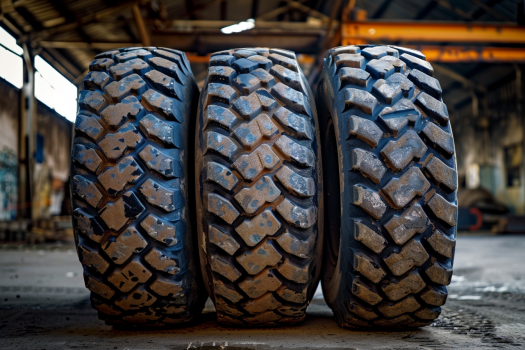
Conclusion & Recommendation
As we wrap up this comprehensive guide on run-flat truck tires, we must reflect on the key takeaways and provide recommendations for truck owners seeking to optimize safety, performance, and longevity.
Striking a Balance Between Safety and Tire Longevity
For truck owners, balancing tire longevity with safety is essential. Run-flat tires provide an extraordinary remedy, allowing drivers to continue driving even after losing air pressure or sustaining a puncture. You can guarantee that your truck stays a safe and dependable means of transportation by being aware of the elements affecting tire longevity, correctly maintaining your vehicle, and choosing run-flat tires wisely.
Run-flat Tires’ Importance for Truck Owners
For truck owners, run-flat tires are incredibly valuable in practicality and safety. These specialized tires save downtime, offer peace of mind during lengthy hauls, and lower the risk of accidents caused by unexpected tire failures. Run-flat tires also provide environmental benefits by reducing waste and carbon emissions associated with tire replacements. For truck owners, investing in run-flat tires is an investment in safety, convenience, and cost-efficiency.
Responsible for Truck Tire Maintenance
Routine truck tire maintenance ensures run-flat tires fulfill their stated advantages. Essential procedures include routine tire inspections, accurate tire pressure maintenance, expert tire services, and following manufacturer recommendations. Using these maintenance procedures, you may minimize the environmental impact of tire replacements, increase the longevity of your run-flat truck tires, and lower the likelihood of accidents.
Recommendation
To implement these principles and experience the benefits of run-flat tires firsthand, we invite you to explore the wide selection of tires available at Tires Easy Truck. Our website, Tires Easy Truck, offers a user-friendly platform where you can find the perfect run-flat tires tailored to your truck’s needs. With our trusted brands, quality assurance, and competitive prices, we make it easy for you to make the right choice for your vehicle.
Make the switch to run-flat tires today, and enjoy the peace of mind that comes with enhanced safety, reduced downtime, and a more sustainable approach to truck tire maintenance. Click the button below to explore our range of run-flat tires and take the first step toward a safer and more efficient journey.
FAQs
How long do run flat tires last?
Run-flat tire lifespans can differ based on driving patterns, upkeep routines, road conditions, and tire type and model. Run-flat tires may generally last between 40,000 and 50,000 miles, the same time as regular tires. However, regular upkeep and attention greatly extend their lifespan.
Do tires that are run flat last less time?
The lifespan of run-flat tires is not innately less than regular tires. In significant part, how they are used and cared for determines how long they last. Severe driving circumstances, incorrect inflation, or irregular rotation may impact the lifespan of run-flat tires. However, if properly maintained, run-flat tires can have a lifespan comparable to regular tires.
Do run-flat tires wear out faster?
When run-flat tires are adequately cared for and driven in typical driving circumstances, they wear at a rate similar to regular tires. Faster wear, however, might result from maintenance neglect, such as failing to monitor and maintain appropriate tire pressure. Severe braking and abrupt bends are examples of aggressive driving behaviors that can cause early tire wear on both run-flat and regular tires.
When should run-flat tires be changed?
Run-flat tires must be changed when they reach a certain tread depth, usually 4/32 inches or less. Insufficient tread depth can cause tires to lose traction, especially in rainy or slick weather, which can be dangerous.
Can you put run-flat tires on a truck?
Yes, run-flat tires are available for trucks, including light-duty and heavy-duty models. Run-flat tires offer enhanced safety and convenience for truck owners, allowing continued mobility even after a puncture and reducing the risk of accidents caused by sudden tire failures. Truck owners should select run-flat tires that match their vehicle’s specifications and requirements.
What is a run-flat tire?
A run-flat tire is a specialized type designed to continue functioning even after experiencing a puncture or significant loss of air pressure. These tires are engineered with reinforced sidewalls and unique internal structures that support the vehicle’s weight when the tire is flat or underinflated. The primary purpose of run-flat tires is to enable drivers to maintain control and drive to a safe location for repair or replacement, reducing the risk of accidents caused by sudden tire failures.
What is the disadvantage of run-flat tires?
Run-flat tires have several drawbacks in addition to their many benefits. One obvious drawback is their ride stiffness, caused by the strengthened sidewalls and the tire’s capacity to carry the car’s weight even when deflated. Furthermore, the cost of replacing run-flat tires may be higher than that of regular tires. They could occasionally also have reduced initial tread life, though regular maintenance can lessen this problem.
Are run-flat tires air-filled?
Yes, run-flat tires and regular tires both require air. The main distinction is that run-flat tires include internal support systems and strengthened sidewalls that maintain the car’s weight even when they lose air pressure from a puncture or other problems.






